 When people mention the word sapphire, they generally mean natural blue sapphire gemstone. The sapphire stones actually exists in various other brilliant colors like yellow, orange, pink, purple and green. These sapphires are called fancy sapphires.
When people mention the word sapphire, they generally mean natural blue sapphire gemstone. The sapphire stones actually exists in various other brilliant colors like yellow, orange, pink, purple and green. These sapphires are called fancy sapphires.
The word Sapphire is derived from Sapphirus, which is Latin for blue. In India it is believed that wearing a sapphire ring or a sapphire bracelet or any other sapphire jewelry item can have either of the two effects ? either the wearer reaches great heights in all aspects of life or is completely destroyed. This is the reason why this gemstone is fairly unpopular in the Indian market. Blue Sapphire is the birthstone for september month.
 There are numerous beliefs, superstitions and folklore that is associated with the blue sapphire gemstone. It is believed to give the wearer everything that he or she desires - health, wealth, longevity and happiness. This gem also restores lost wealth and property, counteracts the envy of enemies and removes the evil eye, protects one from dangers and mental unrest and alleviates long-term misfortune. It is also believed to improve fertility in women.
There are numerous beliefs, superstitions and folklore that is associated with the blue sapphire gemstone. It is believed to give the wearer everything that he or she desires - health, wealth, longevity and happiness. This gem also restores lost wealth and property, counteracts the envy of enemies and removes the evil eye, protects one from dangers and mental unrest and alleviates long-term misfortune. It is also believed to improve fertility in women.
For therapeutic or holistic purposes, the blue sapphire must be set in silver or white metal and worn in the middle finger. The ring should be set with an authentic natural sapphire to be effective.
 Due to the strong beliefs associated with the stone, jewelers in India often suggest this gem be tested (by wearing it next to the skin or keeping it under the pillow while sleeping) for at least one week before final purchase is made.
Due to the strong beliefs associated with the stone, jewelers in India often suggest this gem be tested (by wearing it next to the skin or keeping it under the pillow while sleeping) for at least one week before final purchase is made.
The blue sapphire gem is one of the Navagraha stones (stones that represent the nine planets that have a cosmic influence on all earthlings). It represents the planet Saturn (Shani) and is related to duty and salvation.
Even though blue sapphire gemstones are not so popular in India, they are currently the world's most popular colored gemstone, with the US registering the highest purchases.
 The gems natural blue color has always been associated with royalty. And for centuries the vivid blue sapphire has been a symbol of nobility, sincerity, faithfulness, truth and peace. It is believed to protect its owner from all evils and to also attract divinity. Some communities also believe that this gem has the power to influence spirits and that it protects the owner from witchcraft.
The gems natural blue color has always been associated with royalty. And for centuries the vivid blue sapphire has been a symbol of nobility, sincerity, faithfulness, truth and peace. It is believed to protect its owner from all evils and to also attract divinity. Some communities also believe that this gem has the power to influence spirits and that it protects the owner from witchcraft.
Composition of Blue Sapphire Gemstone
 The chemical formula of Blue sapphire is aluminium oxide (Al 2 O3). The specific gravity ranges between 3.99 and 4.00 and the refractive index range is between 1.760-1.768 and 1.770-1.779. The hardness on the Mohs scale is 9. It is the next hardest mineral, diamond being the hardest.
The chemical formula of Blue sapphire is aluminium oxide (Al 2 O3). The specific gravity ranges between 3.99 and 4.00 and the refractive index range is between 1.760-1.768 and 1.770-1.779. The hardness on the Mohs scale is 9. It is the next hardest mineral, diamond being the hardest.
Blue Sapphire belongs to the gemstone family of corundum. The most pure form of corundum is colorless, but trace elements add color to a corundum gem. While the word ?sapphire? is derived from the Latin word ?sapphirus?, the word ?corundum? is derived from hindu word Kurand or Kuruvinda.
Blue Sapphire Color
Fine medium-dark blue sapphires of rich tone come from Kashmir in India. With their cornflower blue color and a slight milky appearance, Kashmir sapphires of are considered to be the most beautiful gemstones. Color zoning (the uneven distribution of coloring in a gemstone) in a blue sapphire of natural origin is a very common phenomenon. Thus, a rough sapphire stone needs to be cut and faceted in a well planned manner to obtain a beautifully colored finished gem.
Sapphires get their beautiful color tone from the trace elements iron and titanium. The blue sapphires that are found in the basaltic rock have a better color as compared to the others as basalt is rich in iron.
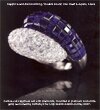 Cut
Cut
A natural blue sapphire is commonly cut into a oval shape to retain maximum weight and obtain a high carat polished sapphire gem. But other shapes like round, cushion, octagonal and rectangle are also not uncommon and depend on the native cut that is provided. Natural blue star sapphires has to be cut in cabochons to display the asterism in the gemstone.
Carat
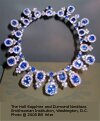 A large number of famous sapphires have been listed in history. Harry Winston, the famous American gem dealer, possesses a 337.10 carat gorgeous sapphire. A 536 carat star sapphire known as the Star of India, probably the largest such gem in the world and a smaller gem of 116cts called the Midnight star, both reside at the American Museum of Natural History in New York City. While the National Museum of Natural History, Washington D.C. houses the 422.99 carat Logan sapphire and the 182 carat Star of Bombay. Another example of a huge-sized sapphire is the 2302 carat sapphire that was carved by Norman Maness into the form of Abraham Lincoln?s head.
A large number of famous sapphires have been listed in history. Harry Winston, the famous American gem dealer, possesses a 337.10 carat gorgeous sapphire. A 536 carat star sapphire known as the Star of India, probably the largest such gem in the world and a smaller gem of 116cts called the Midnight star, both reside at the American Museum of Natural History in New York City. While the National Museum of Natural History, Washington D.C. houses the 422.99 carat Logan sapphire and the 182 carat Star of Bombay. Another example of a huge-sized sapphire is the 2302 carat sapphire that was carved by Norman Maness into the form of Abraham Lincoln?s head.
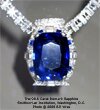 The Ceylon blue sapphire, the Bismark sapphire is 98.60 carats and another reminder of the beauty of the Sri Lanka blue sapphire. Due to the rare nature of the large sapphire gems, gems above 15 carats with good color and clarity grade are considered extremely exotic.
The Ceylon blue sapphire, the Bismark sapphire is 98.60 carats and another reminder of the beauty of the Sri Lanka blue sapphire. Due to the rare nature of the large sapphire gems, gems above 15 carats with good color and clarity grade are considered extremely exotic.
Clarity
 Color zoning and silk (included in rutile needles) are the most striking features of the sapphire gem. Other visible inclusions that are commonly found are crystals and feathers. loupe clean sapphires are very expensive as compared to the slightly included or eye-clean sapphires.
Color zoning and silk (included in rutile needles) are the most striking features of the sapphire gem. Other visible inclusions that are commonly found are crystals and feathers. loupe clean sapphires are very expensive as compared to the slightly included or eye-clean sapphires.
The price of the blue sapphire depends mainly on the color of the gem. Although the gem cut and gem clarity also affect price, the influence that the color has on the price is far more significant. Another aspect that is extremely important is clarity. This is so because a blue sapphire with no natural inclusions is a rarity. And therefore a blue sapphire gem with a high clarity generally fetches an extremely high price.
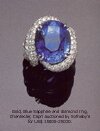 Kashmir blue sapphire gemstones are best blue sapphires and are the finest among those that can be found and they can fetch a very exotic price in the market. A royal blue untreated Kashmir sapphire can exceed $ 1500 per carat in price. The natural unheated and untreated blue ceylon sapphire (Now Sri Lanka) is sold in the regular range of $100 to $400 per carat.
Kashmir blue sapphire gemstones are best blue sapphires and are the finest among those that can be found and they can fetch a very exotic price in the market. A royal blue untreated Kashmir sapphire can exceed $ 1500 per carat in price. The natural unheated and untreated blue ceylon sapphire (Now Sri Lanka) is sold in the regular range of $100 to $400 per carat.
Depending on the quality of the stone, sapphires can also be found beyond this range. Australian sapphires are dark blue in color with very less transparency and cost is around $75 to $125 per carat.
The cornflower blue sapphires from Kashmir are the most preferred gems. However political tension in the region has reduced the miners from doing any mining activity in this region and the gemstone has not been mined for many years. The brilliance of the blue sapphires from Burma (now Myanmar) and Sri Lanka also fetch an exotic price in the market.
The so-called ?Geuda? white non-transparent rough sapphire from Sri Lanka was found to produce magnificent transparent gems on enhancement. Besides the Burmese and Sri Lankan mines, there are others that produce special good quality sapphires, like the mines in Cambodia, Madagascar, Thailand, Australia, USA, Nigeria and Kenya.
 Treatments or enhancements on the sapphire gemstone are done to either make the color light or dark or to improve the clarity and transparency. This is obviously done so that the sapphire gemstone can fetch a better price in the market. However, it is ethically important for a dealer, to disclose whether the sapphire is heated or unheated or whether a treatment has been done on the gemstones while trading.
Treatments or enhancements on the sapphire gemstone are done to either make the color light or dark or to improve the clarity and transparency. This is obviously done so that the sapphire gemstone can fetch a better price in the market. However, it is ethically important for a dealer, to disclose whether the sapphire is heated or unheated or whether a treatment has been done on the gemstones while trading.
Close inspection by an expert can also reveal the treatment that has been done and other faint natural inclusions. Almost 95% of the blue sapphires sold in the market today are treated.
Heat treatment and surface diffusion are the treatments that are commonly done on these gems. The type of heat treatment done is different based on the quality and gem?s natural origin of the gemstones. Heat treatment involves the heating of a gemstone at a temperature that ranges between 450C to 1900C for a certain period of time (about 1 hour to 14 days). After being heated, the stone then goes through a cooling process to ensure that what comes out is a deep blue sapphire gem.
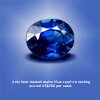 Surface diffusion treatment is mostly done if the heat treatment is not able to improve the color of the gem. Surface diffusion involves heating the gemstone slightly close to its melting point. This is done along with chemicals like aluminum oxide, iron and titanium. The chemicals that are absorbed into the stone form a thin layer of color on the surface of the gem, thus enhancing the over all color of the gemstone.
Surface diffusion treatment is mostly done if the heat treatment is not able to improve the color of the gem. Surface diffusion involves heating the gemstone slightly close to its melting point. This is done along with chemicals like aluminum oxide, iron and titanium. The chemicals that are absorbed into the stone form a thin layer of color on the surface of the gem, thus enhancing the over all color of the gemstone.
Synthetic man made or lab sapphires are produced in many countries in large quantities. In 1947, the Linde Company introduced synthetic red and blue star corundum. This star sapphire gem is particularly used to make men?s star sapphire rings. These gems are now also produced in West Germany, Japan, and Israel for mens sapphire rings and other sapphire jewelry. Linde also utilized similar technology to develop a method for enhancing both color and asterism in natural sapphires, but the company ceased production long ago.
Spinel, aquamarine, cobalt glass, tourmaline, zircon, kyanite, zoisite, synthetic sapphire, benitoite and iolite are gemstones that closely resemble the blue sapphire.
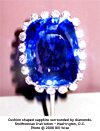 The royal blue colored sapphire gemstone and the beautiful red colored ruby gemstone belong to the same family of gemstones ? the corundum. They have the same chemical composition - aluminum oxide. The cause of the red color in the ruby gemstone is chromium and the blue color of the sapphire is caused due to the presence of iron or titanium.
The royal blue colored sapphire gemstone and the beautiful red colored ruby gemstone belong to the same family of gemstones ? the corundum. They have the same chemical composition - aluminum oxide. The cause of the red color in the ruby gemstone is chromium and the blue color of the sapphire is caused due to the presence of iron or titanium.
Blue sapphire birthstone is for people born in the month of September. It is also called as the September Birthstone.
1) Webster
2) Gemmology by Peter G.Read
3) Handbook of Gem Identification - Richard T.Liddicoat, jr
4) Gems and Crystals - From the American Museum of Natural History - Anna S.Sofianides and George E.Harlow.
Home | Add URL | About Us | Contact Us | Links | Privacy Policy | Resources | Sitemap | Design by Paper Tree
Copyright 2007 GehnaBazaar.com. All rights reserved. The information contained in this webpage may not be published, broadcast, rewritten or redistributed without a prior written consent. Natural Gemstones | Precious Gemstones | Jewellery Designers | Jewelry Institutes | Jewelery Design Institutes | Gemstone Information | Diamond Information | Gemmological Laboratories | Gem Labs | Jewelry Articles | Gold Price | Jewel Store | Buy and Sell Jewellery | Jewery Classes | Deisgn classes | Gemologists | Diamond Price